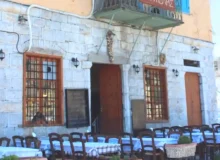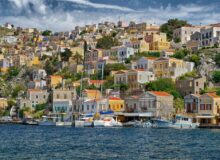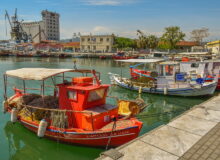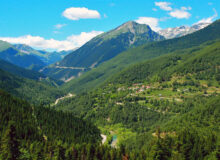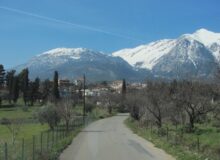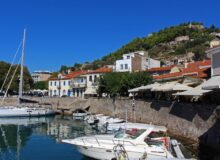The See Greece guide to the island of Kalymnos with a brief history and travel information on how to get there by ferry or by air and what to see and do.

Introduction to Kalymnos
Kalymnos is a rugged and captivating Greek island in the southeastern Aegean Sea, part of the Dodecanese. Known for its dramatic landscapes, vibrant culture, and world-class rock climbing, Kalymnos offers a mix of adventure, history, and traditional Greek island charm. Unlike some of its more tourist-heavy neighbors, Kalymnos retains an authentic atmosphere, making it ideal for travelers seeking both relaxation and exploration.
Location and Geography

Kalymnos lies between the islands of Kos and Leros, close to the Turkish coast. Its terrain is mountainous, with deep valleys, rocky cliffs, and a few fertile plains where citrus trees and olive groves thrive. The island’s coastline features secluded coves, pebble beaches, and small fishing villages, while its main town, Pothia (also called Kalymnos Town), serves as the bustling capital and port.
A Brief History of Kalymnos
Kalymnos has a rich history shaped by its strategic position in the Aegean. In ancient times, it was known for its sponge-diving industry, which brought wealth and recognition. The island was part of the Roman and Byzantine Empires before being occupied by the Knights of St. John in the 14th century.
In the 16th century, the Ottomans took control, ruling until 1912 when Italy seized the Dodecanese during the Italo-Turkish War. After World War II, Kalymnos, along with the rest of the Dodecanese, officially became part of Greece in 1948.
The island’s sponge-diving heritage remains a key part of its identity, celebrated in museums and local traditions. Today, Kalymnos is also famous as a rock-climbing destination, attracting outdoor enthusiasts from around the world.

What to See and Do on Kalymnos
1. Explore Pothia (Kalymnos Town)
Pothia is the island’s lively capital, with colorful neoclassical houses, waterfront tavernas, and a bustling harbor. Key sights include:
– The Sponge Diving Museum – Learn about the island’s historic sponge trade.
– The Archaeological Museum – Features artifacts from ancient Kalymnos.
– The Cathedral of Christ the Savior – A striking Orthodox church with impressive frescoes.
2. Visit the Castle of Chora (Pera Kastro)
Perched on a hill above Pothia, this medieval castle was built by the Knights of St. John. The climb rewards visitors with panoramic views of the island and the sea.
3. Discover Vathy Valley
A lush, green valley surrounded by towering cliffs, Vathy is known for its citrus orchards and traditional tavernas. It’s a peaceful retreat and a great spot for hiking.
4. Relax on Kalymnos’ Beaches
While not as sandy as other Greek islands, Kalymnos has beautiful pebble and rocky beaches:
– Massouri – The most popular beach, with crystal-clear waters and seaside bars.
– Emporios – A quieter beach near a charming fishing village.
– Kantouni – A family-friendly beach with shallow waters.
– Armeos – A secluded spot perfect for snorkeling.

5. Rock Climbing
Kalymnos is one of the world’s top rock-climbing destinations, with over 3,000 routes for all skill levels. The best areas include:
– Grande Grotta – A famous overhanging cave.
– Spartacus – A challenging route with stunning sea views.
– Poets – Ideal for intermediate climbers.
6. Take a Boat Trip to Telendos
The tiny island of Telendos, just a short boat ride from Myrties, offers pristine beaches, hiking trails, and excellent seafood tavernas.

7. Explore the Caves of Kalymnos
The island has several fascinating caves, including:
– Kefala Cave – Contains stalactites and stalagmites.
– Daskalio Cave – Accessible by boat, with impressive rock formations.
8. Experience Local Festivals
Kalymnos has vibrant cultural events, such as:
– Sponge Diving Festival (August) – Celebrates the island’s maritime heritage.
– Easter Celebrations – Known for their solemn processions and fireworks.

Best Time to Visit Kalymnos
The ideal time to visit depends on your interests:
– Spring (April–June) – Pleasant weather, wildflowers, and fewer crowds. Perfect for hiking and climbing.
– Summer (July–August) – Peak season with hot temperatures, lively nightlife, and festivals.
– Autumn (September–October) – Warm seas, lower prices, and great conditions for outdoor activities.
– Winter (November–March) – Quiet, with cooler weather. Some businesses close, but it’s a good time for a peaceful retreat.

How to Get to Kalymnos
By Air
Kalymnos has a small national airport (Kalymnos Island National Airport, JKL), with seasonal flights from Athens (45 minutes). Alternatively, visitors can fly into Kos International Airport (KGS) and take a ferry (1–2 hours) or a speedboat (30–45 minutes) to Kalymnos.
By Ferry
Kalymnos is well-connected by ferry:
– From Piraeus (Athens): Overnight ferries (9–12 hours).
– From Kos: Regular ferries (1–2 hours).
– From Rhodes and other Dodecanese islands: Multiple weekly routes.
Ferry schedules expand in summer, with high-speed options available.

Final Tips for Visiting Kalymnos
– Rent a scooter or car – Public transport is limited, and having your own vehicle helps explore remote beaches and villages.
– Try local dishes – Sample specialties like pitaroudia (chickpea fritters) and fresh seafood.
– Respect climbing etiquette – Stick to marked routes and follow local guidelines.
– Bring sturdy shoes – The terrain is rocky, especially for hiking and climbing.















